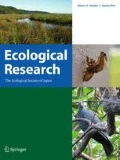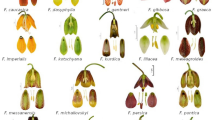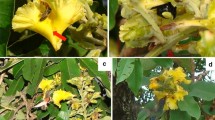Abstract
The variation of floral morphology and its effect on the flower visitors of Polygala vayredae Costa (Polygalaceae), a narrow endemic species from the Oriental pre-Pyrenees, were examined. First, to account for the main floral reward (i.e., nectar), the relationship between the dimensions of the nectar gland and nectar production was investigated. Second, floral traits variation was assessed within and between the three most representative populations of the species. Finally, the role of several floral traits in the female fitness was evaluated. Furthermore, as nectar robbing was highly frequent, preferences of robbers for specific floral traits and their impact on legitimate pollinations were also evaluated. The flowers of this species are characterized by significant variations in floral characteristics and nectar rewards. A significant and positive correlation between the nectar gland dimensions and nectar production per flower was observed, with the gland dimensions being a good measure to infer the rewards offered by the flowers of P. vayredae. In general, corolla traits were significant and positively correlated with each other. Nectar was revealed to be an important trait in flower–visitor interactions, with legitimate pollinations being primarily influenced by this floral reward. Negative correlations between robbing frequency and legitimate pollinations were observed in two of the studied populations, and positive correlations between flower size and robbing frequency were observed in one population. An indirect negative selection over phenotypic floral traits mediated by nectar robbers is proposed.


Similar content being viewed by others
References
Arizmendi MC, Domínguez CA, Dirzo R (1996) The role of an avian nectar robber and of hummingbird pollinators in the reproduction of two plant species. Funct Ecol 10:119–127
Armbruster WS, Di Stilio VS, Tuxill JD, Flores TC, Velasquez Runk JL (1999) Covariance and decoupling of floral and vegetative traits in nine neotropical plants: a re-evaluation of Berg’s correlation-pleiades concept. Am J Bot 86:39–55
Benitez-Vieyra S, Medina AM, Glinos E, Cocucci AA (2006) Pollinator-mediated selection on floral traits and size of floral display in Cyclopogon elatus, a sweat bee-pollinated orchid. Funct Ecol 20:948–957
Berg RL (1959) A general evolutionary principle underlying the origin of developmental homeostasis. Am Nat 93:103–105
Castro S (2007) Reproductive biology and conservation of the endemic Polygala vayredae. PhD thesis, University of Aveiro, Portugal
Castro S, Silveira P, Navarro L (2008) How flower biology and breeding system affect the reproductive success of the narrow endemic Polygala vayredae Costa (Polygalaceae)? Bot J Linn Soc (in press)
Celedón-Neghme C, Gonzáles WL, Gianoli E (2007) Cost and benefits of attractive floral traits in the annual species Madia sativa (Asteraceae). Evol Ecol 21:247–257
Dafni A, Kevan PG, Husband BC (2005) Practical pollination biology. Enviroquest, Cambridge
Eriksen B (1993) Floral anatomy and morphology in the Polygalaceae. Plant Syst Evol 186:17–32
Faegri K, van der Pijl L (1979) The principles of pollination ecology, 3rd edn. Pergamon Press, Oxford
Fenster CB, Cheely G, Dudash MR, Reynolds RJ (2006) Nectar reward and advertisement in hummingbird-pollinated Silene virginica (Caryophyllaceae). Am J Bot 93:1800–1807
Galen C (1999) Why do flowers vary? The functional ecology of variation in flower size and form within natural plant populations. Bioscience 49:631–640
Galetto L, Bernardello G (2004) Floral nectaries, nectar production dynamics and chemical composition in six Ipomoea species (Convolvulaceae) in relation to pollinators. Ann Bot (Lond) 94:269–280
Giles BE, Pettersson TM, Carlsson-Granér U, Ingvarsson PK (2006) Natural selection on floral traits of female Silene dioica by a sexually transmitted disease. New Phytol 169:729–739
Gómez JM (2003) Herbivory reduces the strength of pollinator-mediated selection in the Mediterranean herb Erysimum mediohispanicum: consequences for plant specialization. Am Nat 162:242–256
Gómez JM, Perfectti F, Camacho JPM (2006) Natural selection on Erysimum mediohispanicum flower shape: insights into the evolution of zygomorphy. Am Nat 168:531–545
Hall MC, Willis JH (2006) Divergent selection on flowering time contributes to local adaptation in Mimulus guttatus populations. Evolution Int J Org Evolution 60:2466–2477
Herrera CM (1990) The adaptedness of the floral phenotype in a relict endemic, hawkmoth-pollinated violet. 1. Reproductive correlates of floral variation. Biol J Linn Soc 40:263–274
Herrera CM (1993) Selection on floral morphology and environmental determinants of fecundity in a hawk moth-pollinated violet. Ecol Monogr 63:251–275
Herrera CM (1996) Floral traits and plant adaptation to insect pollinators: a devil’s advocate approach. In: Lloyd DG, Barrett SCH (eds) Floral biology. Chapman and Hall, New York, pp 65–87
Herrera CM, Medrano M, Rey PJ, Sánchez-Lafuente AM, García MB, Guitián J, Manzaneda AJ (2002) Interaction of pollinators and herbivores on plant fitness suggests a pathway for correlated evolution of mutualism- and antagonism-related traits. Proc Natl Acad Sci USA 99:16823–16828
Higashi S, Ohara M, Arai H, Matsuo K (1988) Robber-like pollinators: overwintered queen bumblebees foraging on Corydalis ambigua. Ecol Entomol 13:411–418
Inouye DW (1980) The terminology of floral larceny. Ecology 61:1251–1253
Irwin RE (2006) The consequences of direct versus indirect species interactions to selection on traits: pollination and nectar robbing in Ipomopsis aggregata. Am Nat 167:315–328
Irwin RE, Brody AK (1999) Nectar-robbing bumble bees reduce the fitness of Ipomopsis aggregata (Polemoniaceae). Ecology 80:1703–1712
Irwin RE, Brody AK, Waser NM (2001) The impact of floral larceny on individuals, populations, and communities. Oecologia 129:161–168
Ishii HS, Harder LD (2006) The size of individual Delphinium flowers and the opportunity for geitonogamous pollination. Funct Ecol 20:1115–1123
Lande R, Arnold SJ (1983) The measurement of selection on correlated characters. Evolution 37:1210–1226
Lara C, Ornelas JF (2001) Preferential nectar robbing of flowers with long corollas: experimental studies of two hummingbird species visiting three plant species. Oecologia 128:263–273
Maloof JE, Inouye DW (2000) Are nectar robbers cheaters or mutualists? Ecology 81:2651–2661
Mitchell RJ, Karron JD, Holmquist KG, Bell JM (2004) The influence of Mimulus ringens floral display size on pollinator visitation patterns. Funct Ecol 18:116–124
Morris WF (1996) Mutualism denied? Nectar-robbing bumble bees do not reduce female or male success of bluebells. Ecology 77:1451–1462
Navarro L, Guitián J, Guitián P (1993) Reproductive biology of Petrocoptis grandiflora Rothm. (Caryophyllaceae), a species endemic to Northwest Iberian Peninsula. Flora 188:253–261
Navarro L (1999) Pollination ecology and effect of nectar removal in Macleania bullata (Ericaceae). Biotropica 31:618–625
Navarro L (2000) Pollination ecology of Anthyllis vulneraria subsp. vulgaris (Fabaceae): nectar robbers as pollinators. Am J Bot 87:980–985
Navarro L (2001) Reproductive biology and effect of nectar robbing on fruit production in Macleania bullata (Ericaceae). Plant Ecol 152:59–65
Prys-Jones OE, Corbet SA (1987) Bumblebees. Cambridge University Press, Cambridge
Sánchez-Lafuente AM (2007) Corolla herbivory, pollination success and fruit predation in complex flowers: an experimental study with Linaria lilacina (Scrophulariaceae). Ann Bot (Lond) 99:355–364
Stebbins GL (1970) Adaptive radiation of reproductive characteristics in Angiosperms, I. Pollination mechanisms. Annu Rev Ecol Syst 1:307–326
Sutherland SD, Vickery RK Jr (1993) On the relative importance of floral color, shape, and nectar rewards in attracting pollinators to Mimulus. Great Basin Nat 53:107–117
Thomson JD (1986) Pollen transport and deposition by bumble bees in Erythronium: influences of floral nectar and bee grooming. J Ecol 74:329–341
Traveset A, Willson MF, Sabag C (1998) Effect of nectar-robbing birds on fruit set of Fuchsia magellanica in Tierra del Fuego: a disrupted mutualism. Funct Ecol 12:459–464
Urcelay C, Morales CL, Chalcoff VR (2006) Relationship between corolla length and floral larceny in the South American hummingbird-pollinated Campsidium valdivianum (Bignoniaceae). Ann Bot Fennici 43:205–211
Westerkamp C (1997) Keel blossoms: bee flowers with adaptations against bees. Flora 192:125–132
Westerkamp C, Weber A (1999) Keel flowers of the Polygalaceae and Fabaceae: a functional comparison. Bot J Linn Soc 129:207–221
Zhang Y-W, Robert GW, Wang Y, Guo Y-H (2007) Nectar robbing of a carpenter bee and its effects on the reproductive fitness of Glechoma longituba (Lamiaceae). Plant Ecol 193:1–13
Zimmerman M, Cook S (1985) Pollinator foraging, experimental nectar-robbing and plant fitness in Impatiens capensis. Am Midl Nat 113:84–91
Acknowledgments
The authors thank the Departamento de Medi Ambient of Generalitat de Cataluña and the Consorsi d’Alta Garrotxa for allowing this research to happen and to Parc Natural de la Zona Volcànica de la Garrotxa for all of the support provided. The authors are grateful to Dr. João Loureiro, to Dr. José María Gómez, and to the two anonymous reviewers for their critical reading of the manuscript. Thanks are also due to Dr. Jorge Domínguez for enabling the use of the epifluorescence microscope and to Dr. Susana Loureiro for the helpful discussion on statistical analysis. The Portuguese Foundation for Science and Technology (FCT) financed the work of Sílvia Castro (FCT/BD/10901/2002). The work was partially financed under grants PGIDT04PXIC31003PN from the Xunta de Galicia and BOS2003-07924-CO2-02 from the Spanish DGICYT to Luis Navarro.
Author information
Authors and Affiliations
Corresponding author
Appendix
Appendix
Factor coordinates of the floral traits (corolla tube, keel, crest, and wing) obtained from the principal component analysis (PCA) performed for each of the studied populations of Polygala vayredae.
Population | Montmajor | Serrat dels Boixos | Colldecarrera | |||
|---|---|---|---|---|---|---|
Floral traits | Factor 1 | Factor 2 | Factor 1 | Factor 2 | Factor 1 | Factor 2 |
Corolla tube | −0.7300 | 0.5766 | −0.7572 | −0.4436 | −0.5833 | 0.7265 |
Keel | −0.8525 | −0.3337 | −0.8375 | 0.2602 | −0.8423 | −0.2853 |
Crest | −0.7720 | −0.5495 | −0.6087 | 0.7203 | −0.6810 | −0.6250 |
Wing | −0.8096 | 0.3556 | −0.8130 | −0.3942 | −0.8266 | 0.2931 |
About this article
Cite this article
Castro, S., Silveira, P. & Navarro, L. Floral traits variation, legitimate pollination, and nectar robbing in Polygala vayredae (Polygalaceae). Ecol Res 24, 47–55 (2009). https://doi.org/10.1007/s11284-008-0481-5
Received:
Accepted:
Published:
Issue Date:
DOI: https://doi.org/10.1007/s11284-008-0481-5




